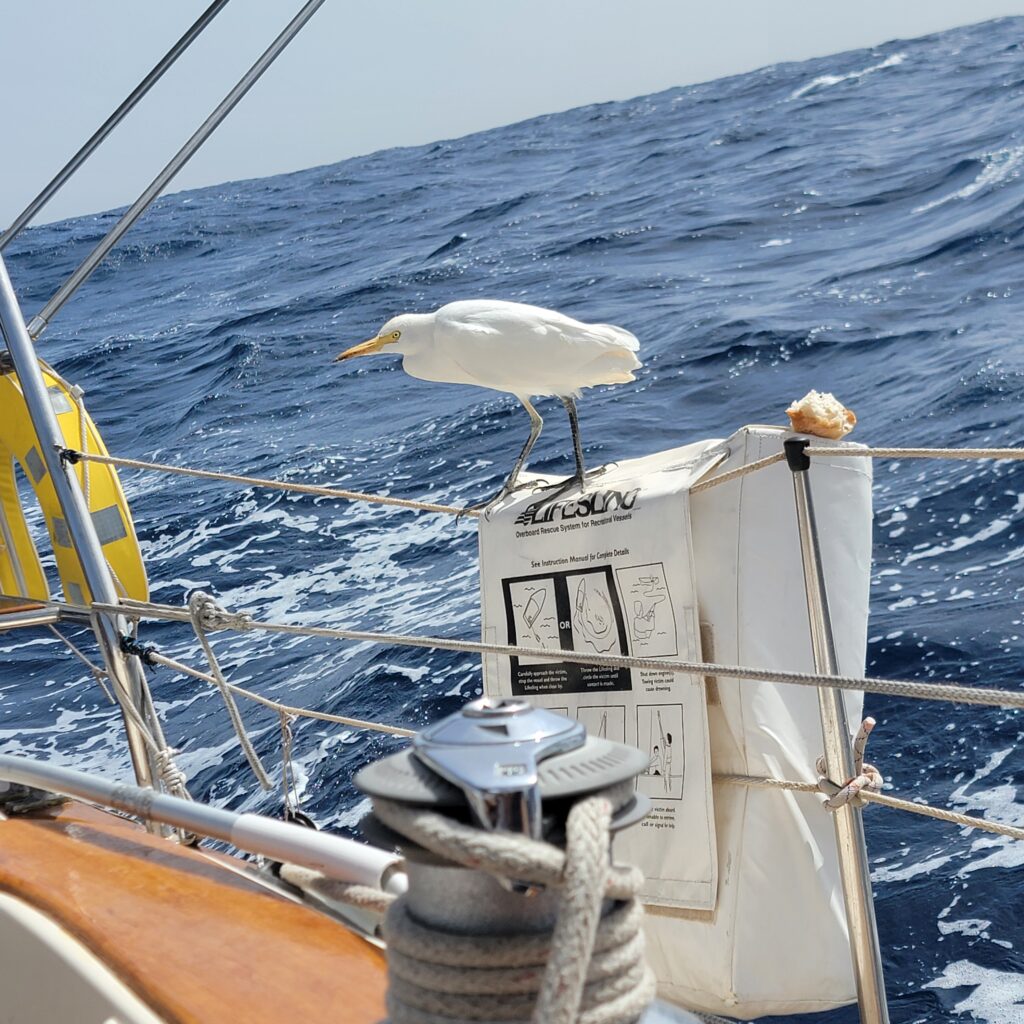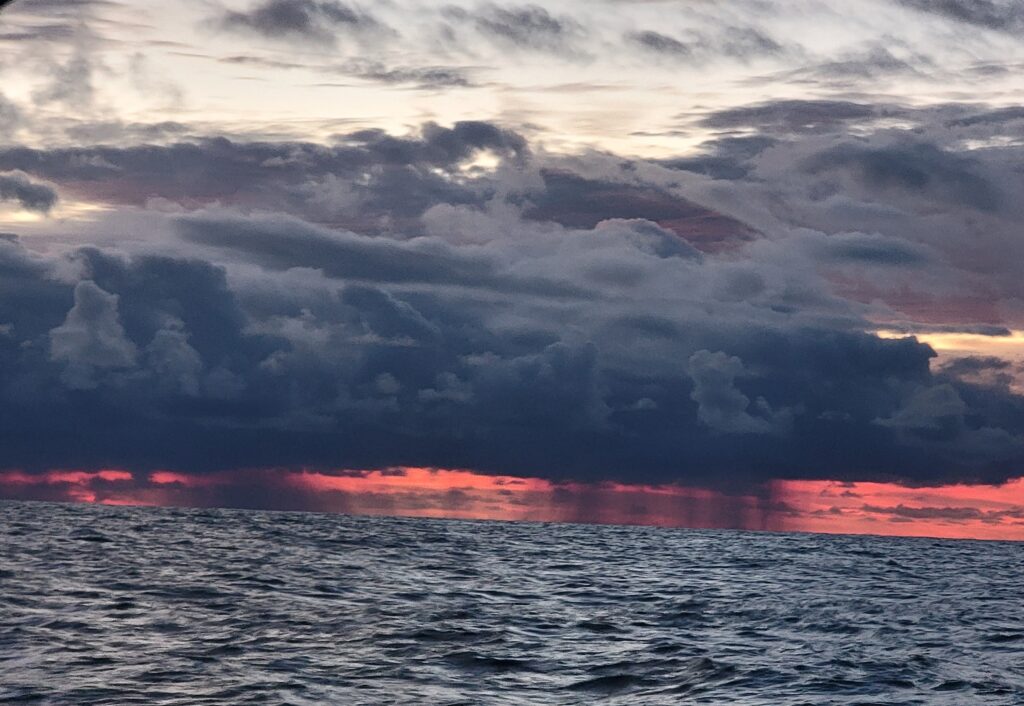
We left Mindelo on Saturday December 7th, heading 2,036 miles west across the Atlantic. Our first task was to get away from the Cape Verde Islands. And as is normal, the winds channeled between islands behind us, gathering strength as we left the island group. Combined with the current wrapping around the island, we had quite a boisterous exit from the islands and out into the ocean.

This is Mindelo harbor on the way out. The easterly winds were blowing strong, bringing big dust clouds from the Sahara Desert. This would clear for us in a few miles offshore, but also provided regularly spectacular sunrises and sunsets.

Theoretically we would be in the nice northeast trades the entire passage, and have a sweet downwind cruise for 14-16 days. But, as always, reality was not the same as the plan. The picture above shows the winds in the mid North Atlantic. The yellow and greens are the 12-18 knot tradewinds that would push us along and create some nice long period waves behind us. But the blue blobs were areas of no wind, and we spent much of our time being chased and caught by the blue blob. Unfortunatley, no wind or light wind does not mean no waves or swells. And in the case of the Atlantic, we had waves coming from multiple directions. Physics 101 tells us that where two 6′ waves meet, you have a 12′ wave. In two words, the passage was slow and rolly. At times, exceptionally rolly.

We didn’t have much rain, until we did. And it rained enough one day to make up for all the sunny days. It was literally a buckle up and hang on and wait it out kinda day, as one storm cell after another rolled over us and dumped torrential rain for a few minutes as it went by. But just like when Rob & I would have days like this in Yohelah, I knew Complexity was up for the task. Jim Cole has taken the best possible care of that boat for the many years and thousands of miles they have sailed, and she took the pounding and howling winds like a champ.

We had a visitor early on the second day, when this egret flew in for a visit. It would circle the boat, land on the lifesling and try to hold on for a while. We were over 100 miles from shore by then, and no one could figure out why this bird was out here. A quick google search returned many responses from other boaters who said it would eventually die of thirst. So I took my leftover breakfast roll and soaked it in water and tucked it in there, hoping the bird would get a drink (we tried a bowl on the deck, but the boat was rolling so hard that didn’t work at all).

Every once in a while the bird would get tired of trying to hold on to the lifesling, and fly around for a while. I kept hoping it would fly off, not really wanting to watch it struggle for days and then just get weak and die. I found a flying fish on the deck and added that to the offering, but that didn’t work either. The good news is, late in the day a second egret flew in when the first one was up trying to balance on the solar panels. At first we thought it was going to be a competition for space to land, but in short order they both flew off together. It looks like they were mates of some sort. What I just absolutely cannot fathom is how one found the other, and what they were doing that far offshore. But it was a much happier ending than I had thought it was going to be.

Marine traffic was exceptionally light. Given that we were on the direct path from Cape Verde and Western Africa into the Caribbean at the beginning of the winter season, I expected to see many more vessels. This is a cruise ship that was on a Miami to Lisbon cruise, doing the exact opposite of us, minus the nice sailing and rolling around. I would guess in 16 days maybe we had sightings visually of 8 boats, and maybe twice that on AIS out of sight. That didn’t stop me from pausing my nightly Netflix video and taking a full horizon scan every 20 minutes on night watch. The stars were epic on some nights, but never matching the brilliance of what we saw in the South Pacific. Maybe it was that Sahara dust?

About halfway across we started to see patches of Sargassum. This is a seaweed that now is a big problem in the Caribbean islands and even up into the US East Coast. When we were in Belize on the beach last year, there were people tasked full time to cleaning the beaches to prevent the smell of rotting seaweed. Nobody wants their white sandy beach replaced with stinky slimy seaweed. From wiki: “The size of annual blooms in the Atlantic increased by over a hundred-fold, starting in 2011, as a result of factors including increased fertilizer runoff in major rivers such as the Amazon and Congo.” Our hotel next week is on the less populated windward side of the island, and we’ll see how much accumulates there.

I did have some time to play with my camera a bit more on this passage. Sometimes it was hard to get that epic sunset shot witout sailboat rigging get in the way. Have a camera with “erase this” feature?

Here you go! I could have done a better job, now that I’m looking at the comparison, but most of the lines are gone. For smaller objects it does a really good job of removing what you don’t want to see.

Am I glad I did this passage? That is another blog post after I get home. Right now it’s Christmas Eve in the Caribbean and I’m here with Rob. For now I’ll leave behind some of those epic sunrise and sunset shots.

This is not edited – just what the camera saw one morning behind us as the sun rose.

This was earlier that morning. Red sky in the morning, as they say, but the squall did rain itself out before it got to us.
Pix from this passage are here